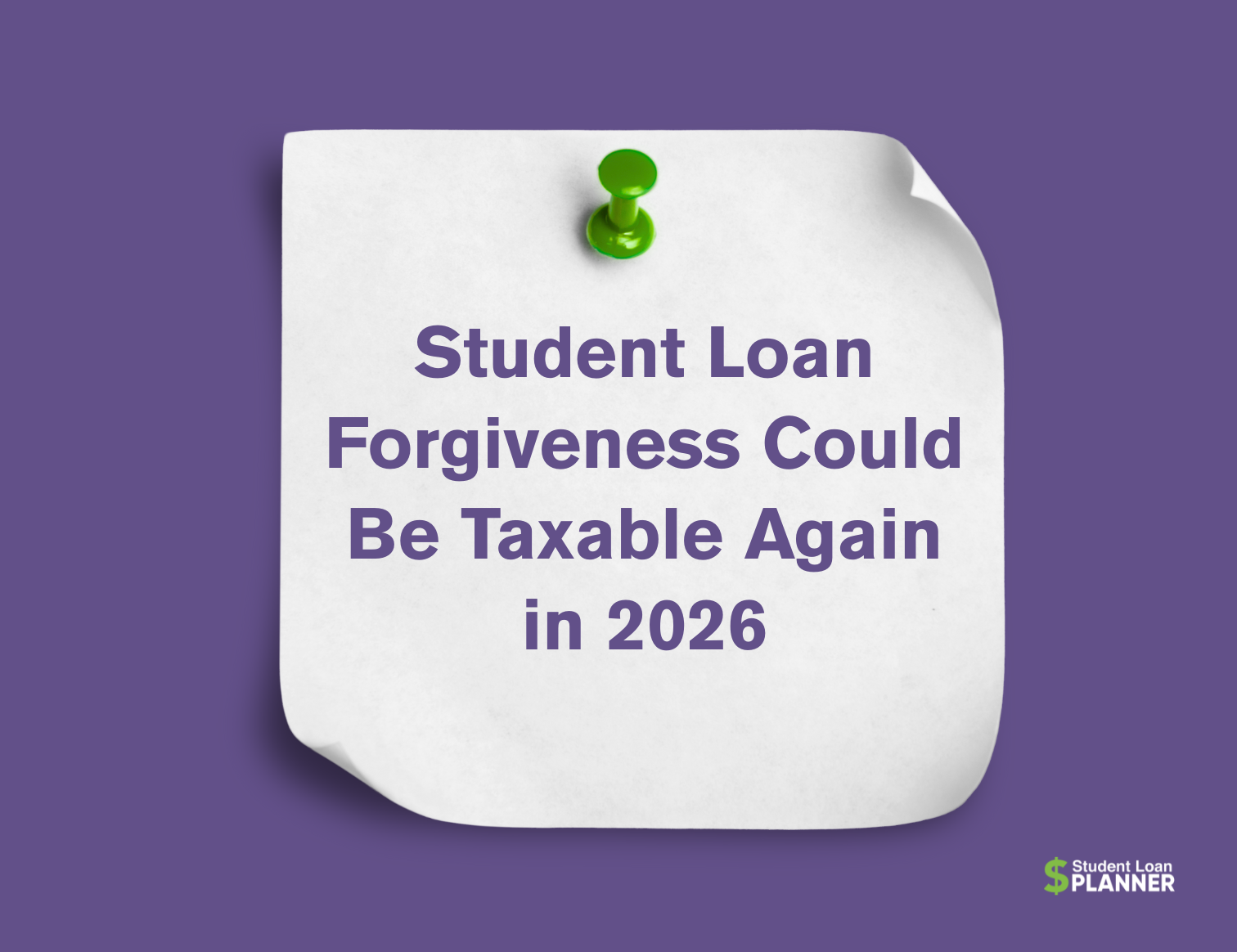
Student Loan Forgiveness Could Be Taxable Again in 2026
A group of Democratic senators is urging the Trump administration to use executive action to shield borrowers from potentially significant tax liability associated with student loan forgiveness that is set to begin starting next year.Historically, student loan forgiveness and other forms of debt cancellation have been treated as taxable events to borrowers.When a debt is cancelled, the lender or loan holder typically issues an IRS Form 1099-C to the borrower, requiring them to report the amount of the discharge as “income” on their tax return.That debt cancellation could then be taxed as ordinary income.
Some forms of student loan forgiveness, such as profession-based discharge programs like Public Service Loan Forgiveness (PSLF) and Teacher Loan Forgiveness (TLF), have been exempt from federal taxation.
But student loan forgiveness under income-driven repayment (IDR) plans goes back to being treated as taxable again starting in 2026 after congressional Republicans declined to extend temporary IDR tax relief that expires at the end of this year. In their letter to Treasury Secretary Scott Bessent and Education Secretary Linda McMahon, Democratic senators argued that the Trump administration has the power to protect borrowers receiving student loan forgiveness under IDR plans from getting hit with massive tax bills.But it remains to be seen whether administration officials will take any action.Here’s what borrowers should know.Student loan forgiveness goes back to being taxable again in 2026 The American Rescue Plan Act, which was signed into law by President Joe Biden in 2021, exempted all federal student loan forgiveness from taxation.
But the provisions of this legislation were temporary.The tax relief associated with student loan discharges is set to end on December 31, 2025.After that date, discharges under certain programs like PSLF will remain tax-free federally, but loan forgiveness under all IDR plans (including IBR, ICR and PAYE) returns to being treated as taxable events again after congressional Republicans declined to extend this relief in the One Big, Beautiful Bill Act that President Trump signed into law in July.Under the tax code, borrowers may have other avenues to potentially reduce or avoid tax liability, even after the relief under the American Rescue Plan Act ends next year.
For example, borrowers whose debts at the time of cancellation exceeded their assets could claim insolvency, demonstrating to the IRS via additional financial statements that their debts are greater than their assets.But not all borrowers would be able to claim this exemption.“Without action from the Trump Administration or Congress, the consequences could be devastating for future beneficiaries of IDR discharge,” wrote Senator Elizabeth Warren (D-MA) along with eight other Democratic senators in the letter this week to Secretaries Bessent and McMahon.“A new economic analysis shows that a typical family headed by a borrower receiving IDR cancellation (i.e., a married parent with two children earning $50,000 a year) would see a $8,789 spike in their tax bill; the same borrower making $40,000 annually would see an even higher tax hit because of reduced access to the Earned Income Tax Credit: $10,295.10.
For many borrowers, these costs are simply too high to bear… These families should not be financially punished for earning debt relief after decades of student loan repayment.” Recent settlement extends tax protections for borrowers who reach student loan forgiveness eligibility in 2025 Borrowers concerned about tax liability associated with IDR student loan forgiveness got a bit of a boost last month after the Department of Education agreed to extend some tax protections to certain borrowers.To resolve an ongoing lawsuit brought by the American Federation of Teachers (AFT) over allegedly stalled or blocked student loan forgiveness, the Trump administration agreed to resume processing student loan forgiveness under the IBR, ICR and PAYE plans.In addition, the department agreed that any borrower who reaches their 20- or 25-year eligibility threshold for IDR loan forgiveness during 2025 will not be issued a Form 1099-C, even if their actual discharge is delayed until 2026. “The defendants shall use only the date a borrower becomes eligible to have their loans cancelled under the IBR, Original ICR, or PAYE plans as the effective date of discharge of their loans,” read the agreement filed in federal district court in October.“The defendants shall not file an Internal Revenue Service (“IRS”) Form 1099-C for borrowers who become eligible for the discharge of their loans in 2025 if the conditions in IRS Notice 2022-1 are satisfied.” However, this only protects borrowers who reach the 20- or 25-year threshold for IDR student loan forgiveness by December 31, 2025.
Borrowers who become eligible for student loan forgiveness under IDR plans starting in 2026 will not be subject to these protections, and could be issued a Form 1099-C, leading to potentially severe tax consequences.Senators ask Trump administration to use executive action to make student loan forgiveness tax-free In their letter to Secretary Bessent, the Democratic senators argued that the Department of Treasury has the power to act without Congress to shield borrowers who qualify for student loan forgiveness starting in 2026 to avoid federal tax liability.“The Treasury Department and IRS could deliver a safe harbor for IDR cancellation recipients using the ‘insolvency exclusion’ and their administrative discretion, as the Trump Administration has previously done for recipients of closed school discharge and borrower defense to repayment,” wrote the senators.“Federal statute dictates that gross income shall not include debt cancellation when a taxpayer is insolvent.
As explained in 26 U.S.C.§ 108, insolvency is ‘the excess of liabilities over the fair market value of assets,’ and the amount excluded from income ‘shall not exceed the amount by which the taxpayer is insolvent.’ There is significant evidence that many IDR beneficiaries are insolvent at the time of discharge.” Borrowers can argue that they qualify for the insolvency exemption on an individualized basis.But, the senators argued, the process for doing so is burdensome, time-consuming, and potentially costly.Instead, they urged Bessent to create an automatic broad insolvency exemption for all IDR borrowers who receive student loan forgiveness.
“Given the data demonstrating the likelihood of insolvency for many IDR discharge recipients and the extraordinary administrative burden of processing individual insolvency requests for taxpayers and the IRS, the agency should issue a blanket safe harbor for IDR cancellation recipients,” wrote the senators.The senators also provided other potential legal arguments for shielding IDR student loan forgiveness from federal taxation, including a “qualified scholarship exclusion” and the “general welfare exclusion,” which provides that “certain payments under legislatively provided social benefit programs that promote the general welfare are excludable from a recipient’s gross income.” What borrowers should know about student loan forgiveness taxation So far, there are no indications that the Trump administration will take the actions that Senator Warren and her Democratic colleagues suggest.If they don’t, and assuming Congress takes no additional action, IDR student loan forgiveness will revert to being taxable again starting in 2026.It is also important to note that not all states will mirror the federal tax treatment of loan forgiveness, so it is possible that for any discharge program, state law may or may not treat the discharge as a taxable event, regardless of what the federal government does. Borrowers on track for any student loan forgiveness program should consult with a qualified tax advisor for guidance and to develop a plan for dealing with any possible tax liability.
Publisher: Source link


